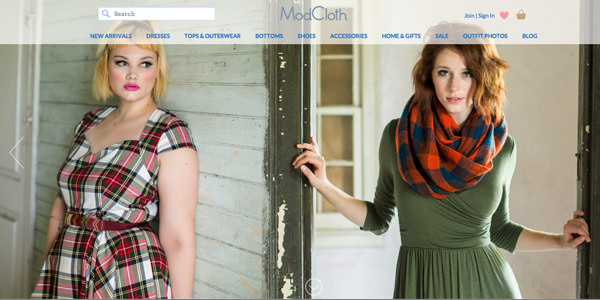
Retailers see minuses in plus-size sections
ModCloth, an up-and-coming e-tailer that caters to a younger, female audience, has folded its plus-size assortment into the rest of its apparel offerings. According to MarketWatch, the company, with clothing it defines as vintage, retro-inspired and indie," conducted a survey in which it found that nearly 65 percent of its shoppers want to see plus sizes included in the same section as other sizes.
"Women prefer to shop by types of clothing, not types of bodies," ModCloth co-founder Susan Koger told MarketWatch.
For women seeking sizes larger than XL on ModCloth.com, clothing is categorized under the term "extended sizes" within each main clothing category.
Ms. Koger indicated in the MarketWatch article that plus-size clothing for women has been the e-tailer’s fastest growing segment in terms of popularity since its introduction in 2013.
ModCloth is thus far an online-only retailer, but the mindset inherent in the change may have implications for apparel retailers with brick-and-mortar presences, influencing in-store clothing placement and store layout.

Source: ModCloth.com
Other apparel retailers are working diligently to cater to the plus-size audience and work towards greater inclusivity in their offerings and messaging when it comes to body types, though some are taking a slightly different tack from ModCloth’s approach. Lane Bryant’s recent #PlusIsEqual campaign, like their #ImNoAngel campaign from last year, made use of plus-size models in lingerie to promote their clothing. The initial #ImNoAngel campaign was in part a critical sendup of the "Perfect Body" campaign launched in 2014 by Victoria’s Secret.
Retailers are also making changes in the way they promote the men’s clothing segment generally known as "Big and Tall." According to an article on the People website, Target recently brought in Zach Miko, the company’s first plus-size male model, to model clothing for the Big and Tall section of the company’s website.
J.C. Penney has likewise made changes to how it treats Big and Tall apparel. In January, the retailer closed its standalone Foundry Big & Tall outlets and is integrating the Foundry brand into J.C. Penney stores.
- ModCloth says 60% of plus-size women are embarrassed to shop separately – MarketWatch
- Lane Bryant’s #PlusIsEqual Campaign Fights for Fair Representation for Women of All Sizes – Style News
- Meet Target’s Only Plus-Size Male Model Zach Miko: ‘I Wouldn’t Have Had the Confidence If It Wasn’t for My Wife’ – People
- J C Penney Shuts Down All Foundry Big & Tall Supply Specialty Stores; Here’s Why – BidnessEtc
Discussion Questions
Does the removal of the plus-size distinction have the potential to catch on in brick-and-mortar stores? How do you see marketing for plus-size audiences continuing to change?


Yes and no. There does need to be some differences in design and styling and as long as those are incorporated, I don’t think it matters where the product sits.
What does matter is that there is SOMETHING out there besides rhinestone sequined tops and stretch-waist pants.
In many ways integrating plus-size clothing makes more sense in brick-and-mortar than it does online. Most people don’t shop by size in-store — if their size isn’t available they will try on whatever is closest and if that doesn’t fit they may try to find it online. This could be a great way to encourage people to try on more clothes and make more purchases — just be sure to have a button or app for those who can’t find their size so that they can request it.
Lands’ End has done this for years … shop for bathing suits and find the longer-waisted sizes right there with the regular ones. I’ll be interested to see whether the use of plus-size models is affected.
I agree that women want to shop for clothing, not for body type. Separating the plus-sizes only creates and reinforces stigma. Lane Bryant’s “Plus is Equal” probably unwittingly perpetuates the problem, simply by calling the sizes “plus.” This is the same old argument — a “woman writer” or a “writer.” Or a “Latino athlete” or “an athlete.” Let’s drop all these identity politics and just sell some clothes!
This is a move that will likely spread to other retailers, especially as larger sizes move toward the norm. Also, it eliminates the salt-in-the-wound phenomenon of common placement of the petites section next to the women’s section. As though it’s not off-putting enough to have to shop in a separate area for larger sizes, you’re right next to those cute petite girls!
While the idea makes sense, should you find an item you like and want to see if it is in your size, there are some differences in what styles work for different body types.
Retailers would be smart to display current trends by body type in order to help shoppers find the shapes that will work best for them. Both on and off line. Let the shopper select their similar body type then see a fashion show of current season items parade in front of them.
In other words, most of us don’t shop by size first. We shop by looks we like and then shapes and colors that work for us. That’s how retail should market to us.
For my 2 cents.
Interesting shift; I like the inclusiveness of it. And it will be more simple to execute. BTW, when does one cross the line to “plus” sizes? Who decides that and what does it say? To the extent there is any stigma attached with being in the “plus” section, remember—there’s no stigma from shopping larger sizes online.
Women do not like to shop by body types, but just like to shop clothes. While it is good to do away with the plus size section online, as people can still search for clothes and filter by available sizes, in stores it would be frustrating to, say, like a piece of clothing and not find it in the right size.